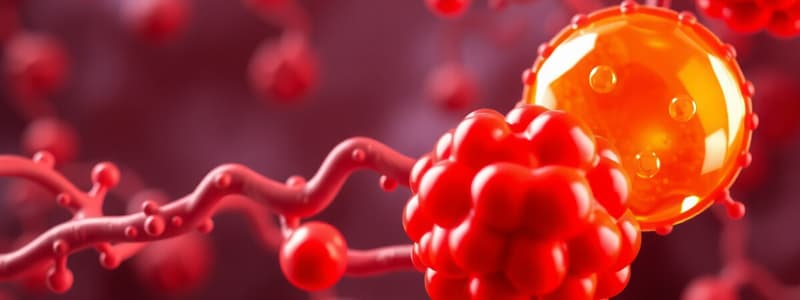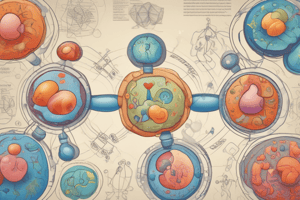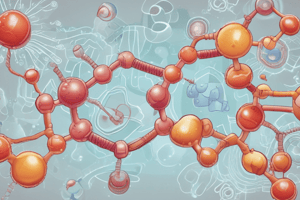Podcast
Questions and Answers
What is the primary form of cholesterol found in plasma lipoproteins?
What is the primary form of cholesterol found in plasma lipoproteins?
- Cholesterol sulfate
- Free cholesterol
- Cholesteryl esters (correct)
- Phosphatidylcholine
Which hormone is responsible for stimulating the phosphorylation and inactivation of HMG-CoA reductase?
Which hormone is responsible for stimulating the phosphorylation and inactivation of HMG-CoA reductase?
- Insulin
- Epinephrine
- Cortisol
- Glucagon (correct)
What role does insulin play in the regulation of cholesterol biosynthesis?
What role does insulin play in the regulation of cholesterol biosynthesis?
- It activates HMG-CoA reductase by dephosphorylation. (correct)
- It encourages the development of cholesteryl esters.
- It stimulates cholesterol degradation.
- It prevents the synthesis of acetyl-CoA.
What is an effect of reduced intracellular cholesterol concentration on cholesterol biosynthesis?
What is an effect of reduced intracellular cholesterol concentration on cholesterol biosynthesis?
What type of enzyme is acyl-CoA-cholesterol acyl transferase (ACAT)?
What type of enzyme is acyl-CoA-cholesterol acyl transferase (ACAT)?
What is the primary role of acyl-CoA synthase in triacylglycerol metabolism?
What is the primary role of acyl-CoA synthase in triacylglycerol metabolism?
Which compound is produced from the action of acyltransferase on glycerol-P?
Which compound is produced from the action of acyltransferase on glycerol-P?
What is the significance of CoA in the synthesis of triacylglycerols?
What is the significance of CoA in the synthesis of triacylglycerols?
Which metabolic pathway is directly linked to the degradation of triacylglycerols?
Which metabolic pathway is directly linked to the degradation of triacylglycerols?
What is the result of the complete hydrolysis of triacylglycerols?
What is the result of the complete hydrolysis of triacylglycerols?
What is the role of malonyl-CoA in fatty acid synthesis?
What is the role of malonyl-CoA in fatty acid synthesis?
Which component of fatty acid synthase is responsible for binding malonyl-CoA and acetyl-CoA?
Which component of fatty acid synthase is responsible for binding malonyl-CoA and acetyl-CoA?
What occurs during the first step of fatty acid synthesis?
What occurs during the first step of fatty acid synthesis?
Which process contributes to the release of CO2 during fatty acid synthesis?
Which process contributes to the release of CO2 during fatty acid synthesis?
What is the main product synthesized from the combination of acetyl-CoA and malonyl-CoA?
What is the main product synthesized from the combination of acetyl-CoA and malonyl-CoA?
Which enzyme is responsible for the formation of malonyl-CoA from acetyl-CoA?
Which enzyme is responsible for the formation of malonyl-CoA from acetyl-CoA?
What is the significance of the acyl carrier protein (ACP) in fatty acid synthase?
What is the significance of the acyl carrier protein (ACP) in fatty acid synthase?
What type of reaction primarily occurs when malonyl-CoA combines with acetyl-CoA?
What type of reaction primarily occurs when malonyl-CoA combines with acetyl-CoA?
Which of the following statements about fatty acid synthase is true?
Which of the following statements about fatty acid synthase is true?
What is released as a byproduct during the condensation reaction of acetyl-CoA and malonyl-CoA?
What is released as a byproduct during the condensation reaction of acetyl-CoA and malonyl-CoA?
Flashcards are hidden until you start studying
Study Notes
Triacylglycerol Metabolism
- Acyl-CoA synthetase catalyzes the synthesis of acyl-CoA from fatty acids.
- Acyl-CoA acyltransferase is involved in the formation of triacylglycerols (TAG) from glycerol-3-phosphate.
- Lipases hydrolyze triacylglycerols to release fatty acids and glycerol for energy metabolism.
- Glycerol-3-phosphate is derived from glucose via glycolysis.
Formation of Triacylglycerols
- Acyl-CoA reacts with glycerol-3-phosphate to form phosphatidic acid, an intermediate in lipid synthesis.
- Phosphatidic acid is converted to diacylglycerol (DAG) through the action of a phosphatase.
- DAG can further react with acyl-CoA to form triacylglycerol, the main storage form of lipids.
Cholesterol Metabolism
- Acyl-CoA cholesterol acyltransferase (ACAT) converts free cholesterol into cholesteryl esters, making it hydrophobic for easier storage within lipoproteins.
- Cholesteryl esters constitute approximately 70% of the cholesterol found in plasma lipoproteins.
Regulation of Cholesterol Biosynthesis
- Cholesterol synthesis is regulated hormonally and transcriptionally at the level of HMG-CoA reductase.
- Insulin activates HMG-CoA reductase through dephosphorylation, promoting cholesterol synthesis.
- Glucagon inhibits HMG-CoA reductase by promoting its phosphorylation, reducing cholesterol synthesis.
Fatty Acid Synthesis
- Fatty acid synthesis begins with the formation of malonyl-CoA from acetyl-CoA, a reaction catalyzed by acetyl-CoA carboxylase.
- The first step in fatty acid chain elongation is the condensation of acetyl groupt and malonyl group with the release of CO2.
Fatty Acid Oxidation
- Glucagon promotes the mobilization of fatty acids from triacylglycerol stores for energy, while insulin aids in their synthesis.
- Malonyl-CoA inhibits carnitine acyltransferase I (CPT I), preventing fatty acid entry into mitochondria during high carbohydrate intake.
- β-oxidation in mitochondria breaks down fatty acids to generate acetyl-CoA for energy production.
Coordination of Fatty Acid Metabolism
- High carbohydrate meals stimulate insulin release, leading to enhanced fatty acid synthesis and reduced degradation.
- Insulin activates ACC, which produces malonyl-CoA, inhibiting CPT I and subsequently β-oxidation, focusing on lipid storage rather than degradation.
Key Enzymes and Processes
- ACAT: Catalyzes transfer of fatty acids to cholesterol.
- HMG-CoA reductase: Central to cholesterol biosynthesis, regulated by hormonal signals.
- Acetyl-CoA Carboxylase: Regulates the first step of fatty acid synthesis.
- Protein phosphatase 1: Activates ACC, linking insulin signaling to lipid metabolism.
Studying That Suits You
Use AI to generate personalized quizzes and flashcards to suit your learning preferences.




